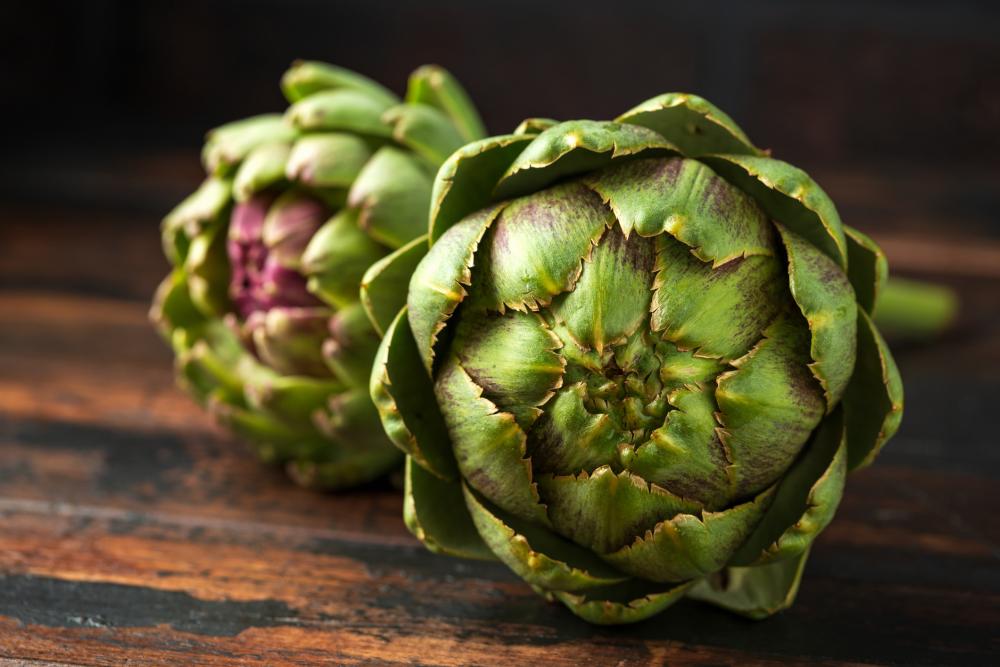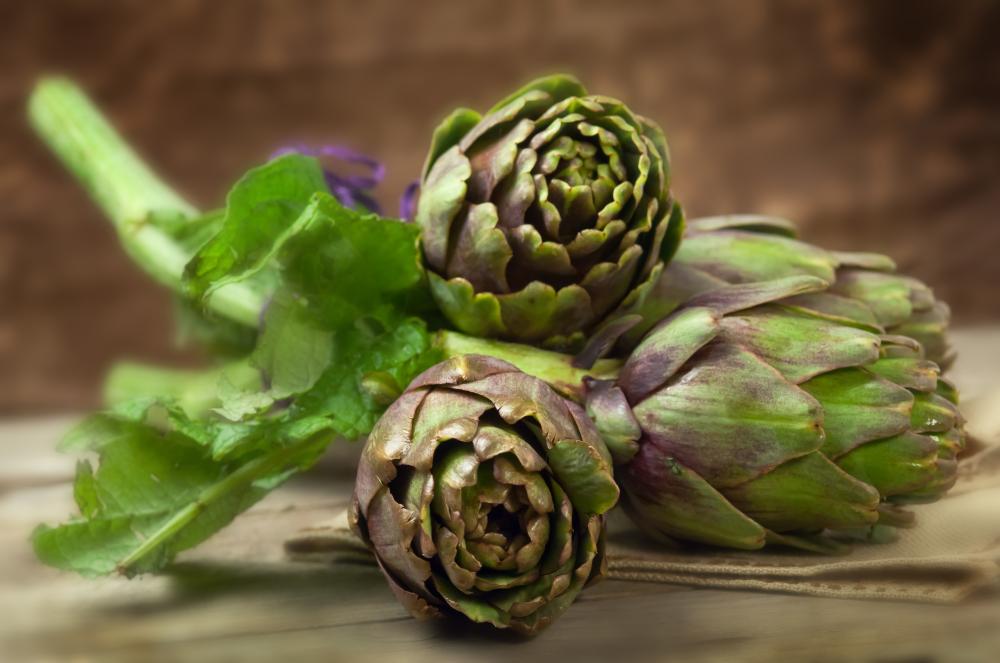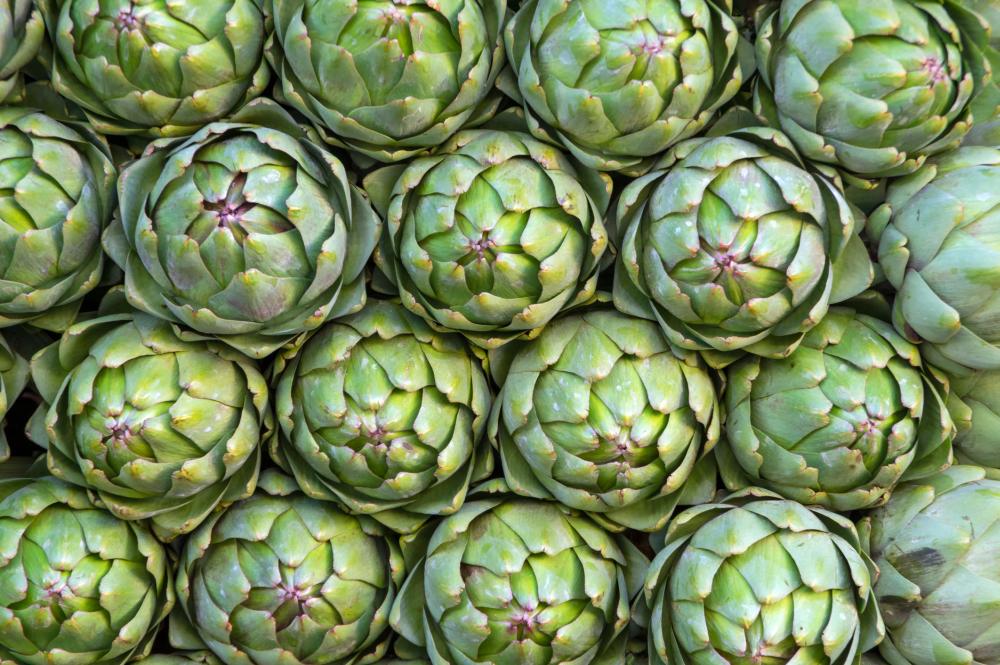8 Popular Artichoke Varieties To Grow In The Garden
A prissy delicacy for some and a staple food for others, artichoke has been a veggie for different tastes. As with many veggies, it's ever meliorate to consume artichoke fresh from the garden. The veggies you lot buy at the grocery store have had a long journey from the farm and are by no means fresh.

That leaves you with i option. To grow artichoke in your garden and savour its flavors at your own leisure. But which artichoke varieties to start with? Admittedly there are many cultivars and species, and they sometimes look and taste the same. Just if you lot do your research, you'll discover more exotic artichoke varieties that accept unique colors, textures, and flavors. The practiced news is we did the research, so yous don't accept to. The following list has some of the most pop varieties and also less-known ones that might surprise you.
Green Globe Improved
The discussion "improved" in the name implies that this is an upgrade on a beta release that didn't exactly do well in the market. Simply that'southward not what happened hither. Light-green Globe is a pop artichoke variety, while the Light-green World Improved is an heirloom cultivar that took the natural variety to new levels of taste and flavors.
The cultivar is suitable for zones 8 to 11 and needs a long growing season. However, yous tin can grow it in colder zones just only every bit an almanac. In that case, it's better to start information technology indoors and harvest the buds as soon as they're ripe since the veggie will not survive the winter.
The average Green Glove Improved plant grows to about 4 anxiety tall. Unlike the original variety, this cultivar can produce almost 4 buds per plant. Each simply grows on elevation of a long and sturdy, 5-inch stem. Don't leave the buds growing once they're ripe otherwise, they will open into a large flower.
It'southward recommended to get-go the seeds indoors about 6 weeks earlier the last frost. That'due south because the seeds demand about 4 weeks to germinate. When the soil warms up outside, transplant the seedlings to rich and well-drained soil in the garden.
Imperial Star
A popular diversity that produces large buds and the yield is quite abundant. Add to that the plant has no thorns, so information technology'due south easy to handle. For all of these reasons, the Royal Star is the darling of commercial artichoke growers. Information technology has high resistance to many diseases and doesn't require a long growing season, as is the case with the Green Globe Improved cultivar.
But one of the main reasons y'all'd want to grow the Imperial Star is that it's a cool-season cultivar that does well both equally an almanac and a perennial. In warm zones, yous tin can keep it throughout the winter and harvest more than buds that way. In cooler zones, information technology does well as an almanac, and you can harvest the buds in the wintertime.
Each establish produces nearly 2 buds on average, each measuring about iv and a half inches wide. Although not every bit productive as the Green World Improved, its loftier tolerance for dissimilar temperatures makes information technology ideal for gardeners every bit well equally artichoke farmers.
To grow information technology in the garden, you'll demand to offset the seeds indoors 8 weeks before the final frost. They have nigh ii weeks or less to germinate, and the seedlings need plenty of light to abound potent and robust stems.

Colorado Star
A cultivar that doesn't crave long growing seasons and reaches maturity faster than other artichoke varieties. It was developed in the Midwest, and Colorado became the offset abode for this hybrid. And since it'southward prepare to harvest within 75 days from the time you start the seeds, that makes it platonic for farms and gardens all across the cool zones of the Midwest.
But that's non the only reason gardeners accepted the new cultivar with open arms. Information technology also has a compact size reaching betwixt 1 to 3 feet. And because of its fast growth rate, yous can notwithstanding abound it successfully even if y'all have a brusk and fleeting summer.
In that location are two types of the Colorado Star. The beginning grows upright and doesn't require any type of back up. The other tends to crawl on the ground, which can betrayal the buds to diseases and pest infestations. It's recommended to provide a stake to keep this blazon growing vertically.
A perennial in zones seven to xi, some Colorado Star varieties have imperial buds. Although the taste is the same whether the plant develops green or purple buds, the latter looks more than appealing when you melt them. Expect each constitute to produce betwixt 4 to 6 buds on average per season.
Purple Italian Globe
Purple is non the kind of color you associate with delicious vegetables. But the Purple Italian Globe shatters that myth and puts purplish food on the culinary map again. Besides, this is an heirloom cultivar that hails from Italy. And while it's used to the warm weather of the Mediterranean, this cultivar tin can tolerate cold temperatures too.
The Purple Italian Globe is also known for its loftier yield. The average plant produces between 6 to 8 buds per flavor. The buds are besides hefty past artichoke standards, with each bud measuring upwardly to 6 inches in diameter. Then you can abound about 2 veggies for every person in the house. The buds too freeze well, so y'all can store them for long periods of time without losing much of the flavor or taste.
The only drawback to this heirloom cultivar is that it requires a long growing season. You can get around this hurdle by starting the seeds 8 to 12 weeks before the last frost. You lot'll likewise need to utilize abound lamps to provide plenty bright light until the weather warms up outside. Expect the vegetables to take up to 120 days before the buds are ripe and prepare to harvest.
Purple Romagna
Once a cultivar hits the market and is well received by hobbyist gardeners and commercial farmers alike, that signals the beginning of a fade. By the time Purple Italian Globe was reaching its peak popularity, another regal cultivar also from Italy was leaving the agricultural labs and making its debut around the homes and farms of Emilia-Romagna, Italy. The Regal Romagna had all the advantages of the Purple Italian Globe with a few improvements of its own.
With remarkable tolerance for both hot and cool weather condition, this cultivar grows to about 5 feet tall and produces large, 3-inch buds. But this is a giant artichoke with a soft eye. Information technology'south another feature that endears this cultivar to the hearts and palates of gardeners and foodies everywhere. All the same y'all choose to melt the bud, the tender heart remains succulent and literally melts on your tongue.
In add-on, the buds come up in different shades of purple and greenish. And you'll simply take to await to see how they look on your plate. That said, the Regal Romagna can take up to 100 days to mature in cool seasons and about 85 days in warm seasons. So you'll need to adjust your planting fourth dimension to permit the vegetable to mature under the warm summertime dominicus.
Violet de Provence
To catch upward on the purple craze and non to be outdone by the Italians, the French came upwards with their ain franco version of the purple artichoke. The Violet de Provence grew out of the warm southern regions of France and is known for its loftier productivity and preference to warm temperatures. As such, it is only suitable for zones 7 to 11 since it cannot tolerate common cold atmospheric condition atmospheric condition even as an annual.
Sporting tightly packed bracts, longish buds, and violet shades, the cultivar is non but delicious but as well hard to come by. Despite its appeal within the borders of borderless Europe, the French cultivar has not made information technology beyond the pond to satisfy the appetites of Usa artichoke fans. And then the only fashion you tin get your hands on the rare seeds is to ask a friend or pen pal in Europe to mail y'all the seeds.
One of the main reasons the Violet de Provence is still a European feature and non a global sensation is that you accept a minor window to harvest information technology. It's all-time eaten as a infant artichoke since information technology tin harden and get chewy if you allow information technology to abound across ii inches across. If you live in a warm zone where the stardom between jump and summer is fuzzy at all-time, then y'all shouldn't allow the buds to even reach 2 inches in diameter. Warm temperatures often speed upwardly the maturity of the cultivar and push information technology toward flowering before its time. So you should harvest it when the bud is only one inch wide.

Tavor
Tavor is a cultivar that takes us dorsum to the familiar green artichoke buds realms. As well producing light green and succulent buds, it doesn't require many arctic hours. So you can plant information technology and harvest the buds in a single season even if the weather was not very accommodating in your zone.
You tin can abound Tavor in zones 7 to xi, although some gardeners reported successful results in cooler zones since the cultivar has some tolerance for common cold temperatures. Merely what really matters for you as a gardener is the high yield of this hybrid.
The Tavor artichoke produces upward to 7 buds per single plant. Out of those seven buds, only two are primary, while the other five are secondary buds. Each bud is almost iv and a half inches in diameter. The mature buds are green all over with a violet tip for decoration.
The establish barely has whatsoever spines and grows to simply a little over 4 anxiety tall. If yous have limited space, you can manage the plant's size to keep information technology within 2 feet high. And as a fast-maturing cultivar, Tavor takes no more than 90 days to be ready for harvesting from the time you plant it.
Violetta di Chioggia
Violetta di Chioggia is another Italian purple artichoke cultivar with a lot going for it. Simply different the other majestic Italian cultivars that grow mainly in the warm south, this one comes from the moderate-to-cool northern region of Veneto, Italy.
Veneto is an innovative region, and its reputation for cultivating hybrids is well known beyond the whole of Europe. They are also famous for their beet cultivars which are both tender and have high concentrations of sugar.
But Violetta di Chioggia is not a sweet veggie. It's tender and has a smooth texture, and the purple buds accept a shapely elongated silhouette. But the main reason y'all'd want to try this cultivar is its loftier tolerance for common cold conditions conditions. It tin can abound well in zone 6 and up. Still, it needs about 120 days to mature, so starting the seeds indoors is required. Each plant produces about 6 to viii buds per season.
Source: https://www.diys.com/artichoke-varieties/
0 Response to "8 Popular Artichoke Varieties To Grow In The Garden"
Post a Comment